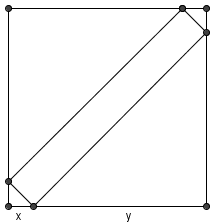2005 PMWC Problems/Problem T8
Problem
An isosceles right triangle is removed from each corner of a square piece of paper so that a rectangle of unequal sides remains. If the sum of the areas of the cut-off pieces is and the lengths of the legs of the triangles cut off are integers, find the area of the rectangle.
Solution
Since the figure in the middle is a rectangle, the isosceles triangles on opposite vertices are congruent. Let ![]() be a leg of the first two, and
be a leg of the first two, and ![]() the other two. The sum of the areas of the triangle is then
the other two. The sum of the areas of the triangle is then ![]() . (remember that the sides are of unequal lengths, so we exclude
. (remember that the sides are of unequal lengths, so we exclude ![]() ). Since squares
). Since squares ![]() , we can reduce our search to even integers, and a short bit of trial and error yield
, we can reduce our search to even integers, and a short bit of trial and error yield ![]() works.
works.
Using subtraction of areas or 45-45-90 triangles, we find that the area of the rectangle is ![]() ; so the area of the rectangle is
; so the area of the rectangle is ![]() .
.
See also
| 2005 PMWC (Problems) | ||
| Preceded by Problem T7 |
Followed by Problem T9 | |
| I: 1 • 2 • 3 • 4 • 5 • 6 • 7 • 8 • 9 • 10 • 11 • 12 • 13 • 14 • 15 T: 1 • 2 • 3 • 4 • 5 • 6 • 7 • 8 • 9 • 10 | ||










